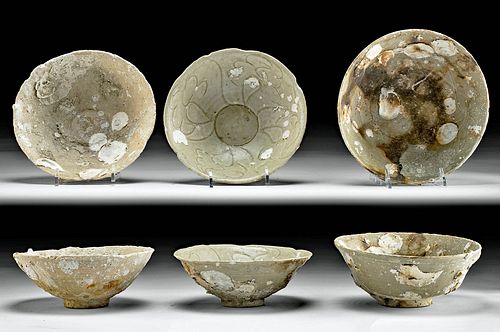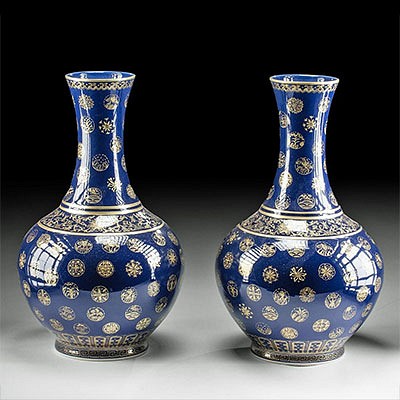Lot of 3 Chinese Song Dynasty Pottery Bowls w/ Shells
Lot 32a
About Seller
Artemis Fine Arts
686 S Taylor Ave, Ste 106
Louisville, CO 80027
United States
Selling antiquities, ancient and ethnographic art online since 1993, Artemis Gallery specializes in Classical Antiquities (Egyptian, Greek, Roman, Near Eastern), Asian, Pre-Columbian, African / Tribal / Oceanographic art. Our extensive inventory includes pottery, stone, metal, wood, glass and textil...Read more
Categories
Estimate:
$1,200 - $1,600
Absentee vs Live bid
Two ways to bid:
- Leave a max absentee bid and the platform will bid on your behalf up to your maximum bid during the live auction.
- Bid live during the auction and your bids will be submitted real-time to the auctioneer.
Bid Increments
| Price | Bid Increment |
|---|---|
| $0 | $25 |
| $300 | $50 |
| $1,000 | $100 |
| $2,000 | $250 |
| $5,000 | $500 |
| $10,000 | $1,000 |
| $20,000 | $2,500 |
| $50,000 | $5,000 |
| $100,000 | $10,000 |
| $200,000 | $20,000 |
About Auction
By Artemis Fine Arts
May 6, 2021
Set Reminder
2021-05-06 10:00:00
2021-05-06 10:00:00
America/New_York
Bidsquare
Bidsquare : Art of Asia | Antiquity to Present
https://www.bidsquare.com/auctions/artemis-gallery/art-of-asia-antiquity-to-present-6908
Featuring antiquities and works of art ranging from the third millennium BCE to the present. From West to East including the Near East and Central Asia, China, Japan, Korea and South and Southeast Asia. Including jades, bronzes, lacquer, textiles, paintings, prints, sculpture, ceramics, more! Artemis Fine Arts info@artemisfinearts.com
Featuring antiquities and works of art ranging from the third millennium BCE to the present. From West to East including the Near East and Central Asia, China, Japan, Korea and South and Southeast Asia. Including jades, bronzes, lacquer, textiles, paintings, prints, sculpture, ceramics, more! Artemis Fine Arts info@artemisfinearts.com
- Lot Description
East Asia, China, Song Dynasty, ca. 960 to 1279 CE. An fantastic trio of wheel-thrown pottery bowls, made in the Chinese Imperial state-owned and operated kilns for ancient trade and domestic use. These special bowls feature natural shell and barnacle embellishments from centuries spent on the ocean floor. Each bowl sits on a ring-shaped foot with thin walls that flare outwards. The first is glazed a beige hue with heavy mineral deposits on the surface. The second dish is a sage green, and features incised abstract motifs with curvilinear striations that create a floral motif on the interior basin. The largest bowl displays the same green hue as the second, but with dark brown areas, probably from time spent in the water and not the firing process since the shells are the same color. A interesting trio embellished by the ocean! Size of largest: 7.25" Diameter x 3" H (18.4 cm x 7.6 cm)
Bowls like these were some of China's most important exports during the Song period, and were admired and emulated in Korea and Japan. These objects were fired in "dragon kilns" - long brick tunnels that rose up a slope to provide slow and even heating. Archaeologists estimate that up to 25,000 vessels would be made at once in the largest of these kilns! The market for bowls like these included the scholar-gentleman class, sometimes known as the literati. These were made for everyday use, religious ceremonies (placing offerings on altars, for example), and sometimes were buried with their owners. These particular bowls were evidently preserved at the bottom of the ocean, perhaps the result of a shipwreck!
Provenance: ex-van Dies estate, Maui, Hawaii, USA acquired before 2000
All items legal to buy/sell under U.S. Statute covering cultural patrimony Code 2600, CHAPTER 14, and are guaranteed to be as described or your money back.
A Certificate of Authenticity will accompany all winning bids.
We ship worldwide and handle all shipping in-house for your convenience.
#151621Nicks and chips to rims and surfaces. Stable hairline fissure on incised bowl. Heavy staining and discoloration on largest. Heavy mineral deposits, shells, and barnacle accumulation on all.Condition
- Shipping Info
-
All shipping is handled in-house for your convenience. Your invoice from Artemis Gallery will include shipping calculation instructions. If in doubt, please inquire BEFORE bidding for estimated shipping costs for individual items.
-
- Buyer's Premium



 EUR
EUR CAD
CAD AUD
AUD GBP
GBP MXN
MXN HKD
HKD CNY
CNY MYR
MYR SEK
SEK SGD
SGD CHF
CHF THB
THB
















